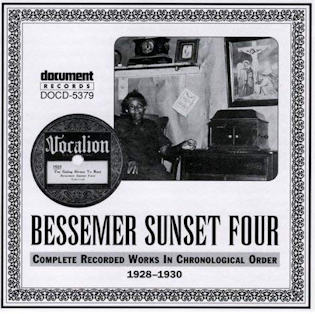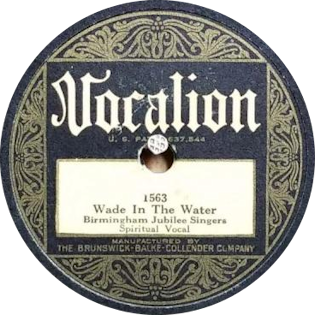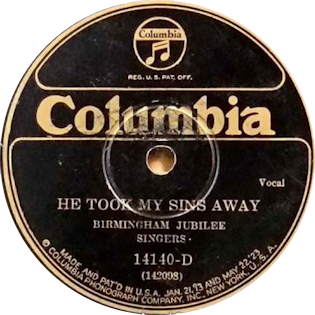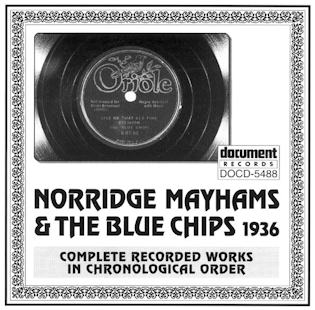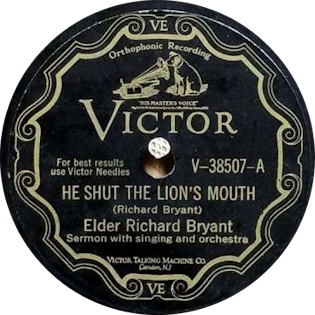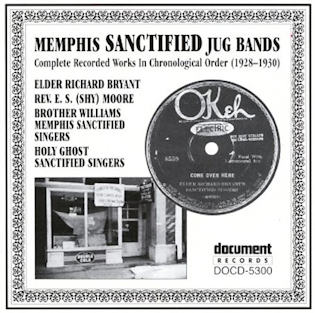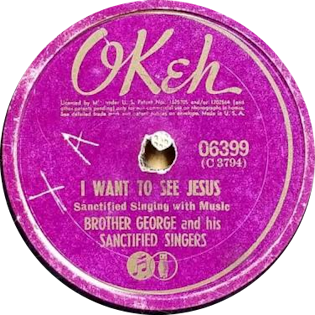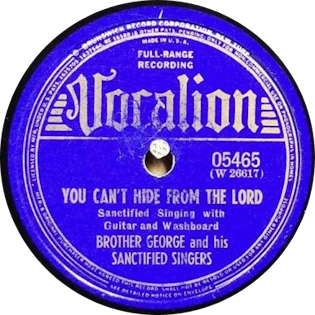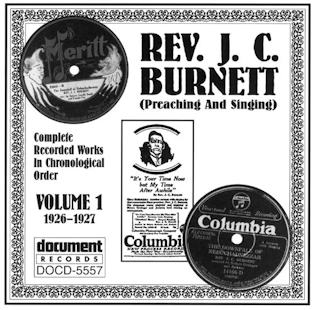 A B C D E F G H I J K L M N O P Q R S T U V W X Y Z
A B C D E F G H I J K L M N O P Q R S T U V W X Y Z
To help with further browsing click on the large ‘Initial’ to return to the Early Gospel Singers Introduction, or click another initial to take you to details of more early gospel singers.
____________________________________________________________________________________________________________________________
| Name: | Deacon L J Bates |
| Aka: | Pseudonym for Blind Lemon Jefferson |
| Name: | Rev. James Beard |
| Location: | |
| Born: | |
| Died: | |
| Biography Synopsis: | Rev. Beard is believed to have been associated with the Biddleville Quintette. – Blues & Gospel Records (1890-1943) Dixon, Godrich and Rye, Oxford University Press, 1997 (Fourth Edition) |
| Recording career: | Four sermons recorded on Paramount, January 1927 |
| Most popular song(s): | “Memory Of Departed Friends” – Click here for recording |
| Musical Influences: | |
| References / links: | |
| Images: |  |
| Name: | Elder Charles D. Beck |
| Location: | |
| Born: | Mobile, Alabama circa 1900 |
| Died: | Circa 1972 |
| Biography Synopsis: | “…. Elder Charles Beck himself is featured on the other 17 tracks on this compilation and they range from vocal and piano renditions of Dorsey’s “Precious Lord” through to the Elder with full congregation including a wild kazoo player on the track “Changes”. What is clear is that Charles was a superb sanctified piano player”. – Tony Cummings, Cross Rhythms: extract from Document BDCD-6035 Review (www.crossrhythms.co.uk) |
| Recording career: | An extensive recording discography, which included over 60 songs over the span of two decades. |
| Most popular song(s): | |
| Musical Influences: | |
| References / links: | AllMusic Bio |
| Images: |  |
| Name: | Biddleville Quintette |
| Location: | Charlotte, North Carolina |
| Biography Synopsis: | The Biddleville Quintette ought now to be recognized as one of the great east coast African American gospel units of the early 20th century. The group waxed 36 sides for Paramount and QRS between September 1926 and August 1929. Original copies of their 78 rpm records are prized by collectors impressed with the Quintette’s passionate intensity and soulful delivery. These feature call and response sanctified singing and sermons peppered with emphatic shouts and hollers. The 1929 recordings include instances of shape-note singing and progressive congregational polyphony that make one wish they’d stayed together and kept cutting records to document the evolution of their style and technique for posterity. In an informational ellipsis worthy of a West African trickster deity, the Biddleville Quintette appeared to be posthumously impossible to pin down, and seemed for quite a while to defy researchers’ attempts to assign them a geographical home base. It took latter-day musical historians a surprisingly long time to locate Biddleville, which is a neighborhood on the north side of Charlotte, N.C., adjacent to the campus of Johnson C. Smith College, formerly known as the Biddle Institute. While precious little information has been uncovered regarding the group, one contemporary recalled that the leader of this four-man-one-woman organization was a manual laborer named Adam Brown who resided in the Biddleville district. He and the Quintette did not record after 1929, but were still performing publicly in Charlotte during the ’30s. All of the Biddleville Quintette’s recordings have been reissued by the Document label.
Source: AllMusic |
| Recording career: | 1926-29 |
| References / links: | This Train Is Bound For Glory – Video
Way Down In Egypt Land – Video Coming To Christ – Video |
| Images: | 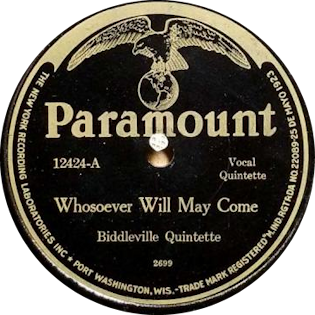 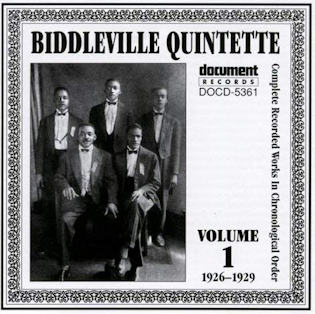 |
| Name: | Birmingham Jubilee Singers |
| Location: | Birmingham, Alabama |
| Biography Synopsis: | The Birmingham Jubilee Singers were an American gospel quartet from Birmingham, Alabama. They were put together in 1926 by Charles Bridges, a native of Birmingham suburb Pratt City, who studied voice at his high school and sang with the Dolomite Jubilee Singers after graduating. Bridges sang lead, accompanied by Leo “Lot” Key, tenor, Dave Ausbrooks, baritone, and Ed Sherrill, who, according to music historian Doug Seroff, was the deepest-voiced of all the bass singers in the Jefferson County movement.
The group became Alabama’s first professional quartet when in 1926 they were discovered by a Columbia Records talent scout, and travelled from Jefferson County to record in Atlanta. They achieved nationwide popularity through their live radio broadcasts over WAPI, WVRC and WJLD. Becoming one of Columbia’s most prolific black vocal groups, they played vaudeville stages in New York and Chicago with the likes of Ethel Waters. They played a mix of both gospel songs and secular material, performing on gospel and vaudeville stages alike. The group disbanded in the 1930s when Dave Ausbrooks died. Their complete recorded works were reissued on two compact discs in 1995 by the Document Records label. Source: Last.fm |
| Recording career: | 1926-29 |
| Most popular song(s): | Wade In The Water
He Took My Sins Away |
| References / links: | Discography of American Historical Recordings |
| Images: | 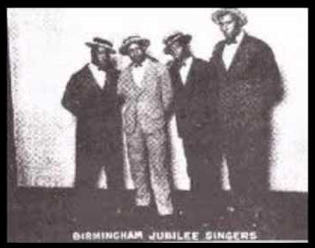 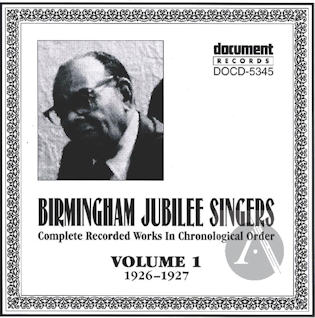
|
| Name: | Rev. Johnnie Blakey |
| Location: | ? |
| Born: | ? |
| Died: | ? |
| Biography Synopsis: | When Reverend Johnny (or Johnnie) Blakey cut his first records for Paramount in Chicago during the autumn of 1927, he delivered his sermons with such visceral urgency that he was billed on the label as Son of Thunder. Nearly 70 years later, Document reissued Blakey’s first 14 recordings together with eight by Rev. M.L. Gipson, who waxed his first four titles in the same studios right around the same time as Blakey made his. Both individuals were affiliated with the Memphis-based Church of God in Christ (COGIC), as was Rev. F.W. McGee, who made the first of his many records a few months prior to Blakey and Gipson’s earliest recording dates. Gipson, who may have accompanied himself on guitar, was an exuberant singer who had a penchant for brandishing biblical references while working himself up into crests of inspiration. There is a wonderful call-and-response passage during “John Done Saw That Holy Number,” and the energetic “Will the Circle Be Unbroken” would compare nicely with the work of Elder Richard Bryant’s Sanctified Singers. These records, which have more musical content than those of Blakey, appear to constitute Gipson’s complete recorded works. Blakey’s output, on the other hand, was reissued by Document on three different collections, including Memphis Gospel: Complete Works (1927-1929) and Preachers and Congregations, Vol. 1. Blakey’s earliest recordings are his least subdued, and his “Let the Light Shine on Me” is a beautiful counterpart to Blind Willie Johnson’s “Let Your Light Shine on Me,” which was recorded in December 1929 and might well have been influenced by Blakey’s record. The breathing pattern of Blakey’s preaching technique should sound familiar to anyone who has listened to a fair amount of traditional African-American sermonizing. It is compared in the liner notes to that of Atlanta preacher Elder J.E. Burch, whose records have also been reissued by Document along with those of a certain Rev. Beaumont. In format and technique, Blakey’s style of presentation — a bit of heartfelt group vocalizing followed by ferocious bursts of emotionally charged testimony interspersed with guttural, almost percussive gasps — has since become widespread in African-American churches across the land. Blakey was among the first to deliver this kind of preaching inside of a recording studio, and these records might well have served to spread knowledge of it throughout North America and Europe, where record collectors have been gathering and preserving them for generations.
Source: AllMusic |
| Recording career: | 1927-28 |
| References / links: | Discography of American Historical Recordings
The Devil Is Loose In The World – Video |
| Images: | 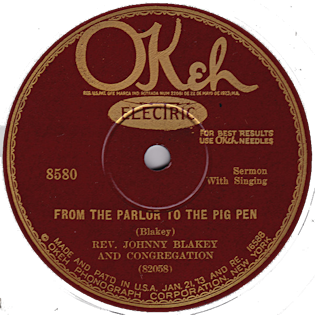 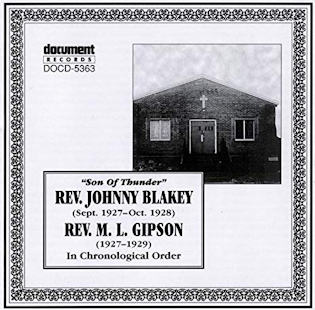 |
| Name: | The Blue Ribbon Six |
| Location: | Cleveland, Ohio |
| Biography Synopsis: | Formed in the 1930s the all female group comprised: Jimmie Weems, Looie Billings, Willie Belle Gervin, Eva Grier, Fannie Blure, Juanita Stewart, and Mildred Jones. |
| Recording career: | 1930s – 1946? |
| Most popular song(s): | |
| Musical Influences: | |
| References / links: | ‘Cleveland’s Gospel Music’, Frederick Burton, Arcadia Publishing 2003 |
| Images: |
| Name: | Joe Washington Brown & Austin Coleman |
| Location: | Louisiana |
| Biography Synopsis: | Spirituals and work songs, rooted in both the slavery era and the West African societies from which most African-American slaves were originally taken, provided cultural sustenance to African Americans in the midst of intense racial oppression. Folklorists first began collecting traditional southern music in the late-19th century. By the 1920s and 1930s, John and Alan Lomax were recording southern musicians (African-American, white, and Mexican-American) for the Library of Congress. “Run Old Jeremiah” (L. of C. Archive of Folk Song AFS L3), sung by Joe Washington Brown and Austin Coleman in Jennings, Louisiana, in 1934, was a ring-shout, a religious song using a West African dance pattern, where the performers shuffled single file, clapping out a complex counter-rhythm. The ring-shout was common during slavery and remained popular well into the 20th century as a means of emotional and physical release during religious worship. The lyrics of the ring-shout spoke of escape from the travails of the present. – American Social History Project (http://ashp.cuny.edu/) |
| Recording career: | 1934 |
| Most popular song(s): | “Run Old Jeremiah” – Click here for recording |
| Musical Influences: | |
| References / links: | |
| Images: |  |
| Name: | Bryant’s Jubilee Quartet/ette |
| Aka: | The Famous Garland Jubilee Singers |
| Location: | Richmond, IN |
| Biography Synopsis: | Like many of the early to mid-20th century gospel groups whose surviving works were reissued by Document during the ’90s, little or no information has been uncovered concerning the unit that recorded in 1928 and 1931 as Bryant’s Jubilee Quartet and Quintette. No connection has been established between this group and the sanctified jug band led by Elder Richard Bryant in Memphis in 1928; nor does the fact that one of their records was issued under the name of the Alabama Jubilee Quartet prove that they had any ties to the gospel scene centered in Jefferson County, AL, which was best represented by the popular Birmingham Jubilee Quartet. Bryant’s Jubilee Quartet and Quintette left a total of 29 recordings, 25 of which were compiled onto one disc in 1996. From “Creep Along, Moses” onward, each performance is solid and reassuring, with warm harmonies and frequent use of rolling rhythms that are most appealing. About half of these songs are sung a cappella, and the unidentified pianist who propels and accents the group on the other sides was artful enough to contribute just the right measure of support, both sanguine and subtle. The song selection on this enjoyable collection includes remake versions of “Who Stole de Lock Off de Hen House Door?” and “Every Time I Feel the Spirit,” as well as “Ezekiel Saw de Wheel,” “This Train,” and “I Want to Be Ready.” “Do You Call That Religion?” is a cousin to “Scandalize My Name,” and the refrain on “When the World’s on Fire” is recognizable as the root of Woody Guthrie’s “This Land Is Your Land.” A steaming hot version of “Who Stole the Lock?” was recorded in 1932 by singing trumpeter Henry Red Allen with an all-star jazz band billed as the Rhythmakers. Four remaining sides from the Bryant Jubilee group’s March 20, 1931 session were added to Document’s complete edition devoted to the Dixie Jubilee Singers. And it’s all good.
Source: AllMusic.com |
| Recording career: | 1928 – 1931 |
| Most popular song(s): | |
| References / links: | |
| Images: | 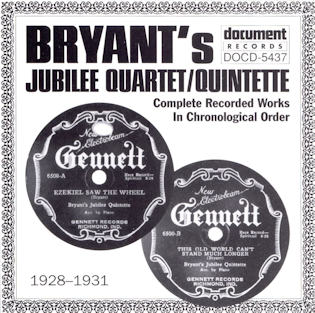 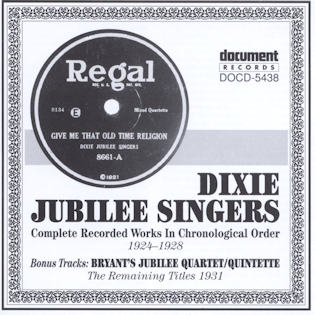 |
| Name: | Elder Richard Bryant’s Sanctified Singers |
| Location: | Memphis, TN |
| Born: | ? |
| Died: | ? |
| Biography Synopsis: | Mississippi Delta preacher – a prolific performer in the Sanctified Jug Band style |
| Recording career: | 1928 – 1930 |
| Most popular song(s): | Recorded 10 songs (plus 3 second takes) in 1928 – all on DOCD 5300 |
| References / links: | Discography of American HIstorical Recordings |
| Images: | 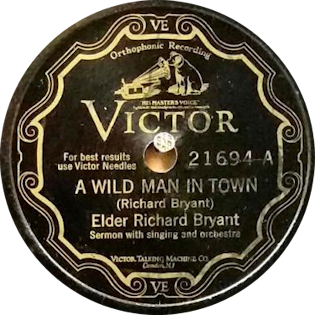 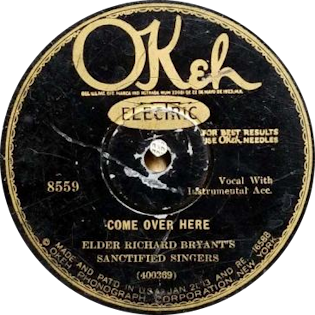
|
| Name: | Elder J. E. Burch |
| Location: | Atlanta, GA? |
| Born: | ? |
| Died: | ? |
| Biography Synopsis: | |
| Recording career: | 1927 |
| Most popular song(s): | |
| Musical Influences: | |
| References / links: | |
| Images: |  |
| Name: | Rev. J. C. Burnett |
| Location: | Mobile, AL |
| Born: | ? |
| Died: | ? |
| Biography Synopsis: | Reverend J. C. Burnett was an American preacher who recorded gospel songs and sermons extensively in the late-1920s and intermittently thereafter until the 1940s. During his heyday, recording for Columbia Records, Burnett was one of the most commercially successful preachers on race records, alongside Reverend J. M. Gates and Reverend A. W. Nix. Years following Burnett’s close of his recording career, his sermons still receive attention on compilation albums and from musical artists, particularly Bob Dylan.
A native of Mobile, Alabama, Burnett joined the Baptist ministry in 1911, preaching “good old-fashioned sermons in a manner made famous by the Reverend J. M. Gates”, as writer Lerone A. Martin noted in his book Preaching on Wax: The Phonograph and the Shaping of Modern African American Religion. The self-taught Reverend, who proudly proclaimed he “never spent a day at school”, began achieving success preaching on the gospel tent circuit in Louisiana, Mississippi, and Texas. Burnett was first recorded by the small Kansas-based record label, Merit Records, which was managed by musician and music store owner Winston Holmes. With Holmes, the Reverend recorded his sermon, “The Downfall of Nebuchadnezzar”, and, despite limited promotional capacities, a Columbia Records talent scout “discovered” Burnett in late-1926. However, the Reverend’s work with Columbia was briefly delayed as Holmes, who still had a recording contract with Burnett, filed a lawsuit against the label, which he consequently lost. Burnett re-recorded “The Downfall of Nebuchadnezzar”, and the sermon sold unexpectedly well—approximately 80,000 copies in total—as listeners were interested in the Reverend’s emotive interpretation of Daniel 4:14. Settled in New York City, Burnett, from 1926 to 1929, recorded 32 sermons (four unissued), becoming one of the more extensively represented preachers on record. Most of the Reverend’s work saw him accompanied by vocalists Sister Ethel Granger and Odette Jackson, and organist Porter Grainger. Inspired mainly by the writings found in the Book of Revelation, the Reverend found additional success with sermons such as “The Great Day of His Wrath Has Come”. The Reverend took a nine-year hiatus from recording, but returned to New York City in 1938 to record eight sermons for Decca Records, including another version of “The Downfall of Nebuchadnezzar”. Burnett’s former organist, Grainger, recommended the Reverend to record producer Joe Davis in 1945, leading to eight more sermons (two unissued) being released on Davis’s Jay Dee label. As many as 16 sermons were anticipated to be released; however, in February 1946 Davis bought out the remainder of the Reverend’s recording contract for $100.00. The Reverend’s later life is unknown, but it is speculated he returned to preaching until his death. Burnett is the first individual to record the widely-covered song “Jesus Make Up My Dying Bed”, although his rendition was never released officially. Nonetheless, the composition is thought to have influenced Blind Willie Johnson’s version of “Jesus Make Up My Dying Bed”. Versions by Charley Patton, Bob Dylan, John Sebastian, and Led Zeppelin have also followed over the years. Dylan recorded the Christian hymn, “Will the Circle Be Unbroken”, in response to Burnett’s version, and released the tape on the compilation album The Bootleg Series Vol. 11: The Basement Tapes Complete, in 2011. Source: Wikipedia |
| Recording career: | 1926 – 1929 & 1938 – 1945 |
| Most popular song(s): | “The Downfall of Nebuchadnezzar”
“Jesus Make Up My Dying Bed” |
| References / links: | Discography of American Historical Recordngs |
| Images: | 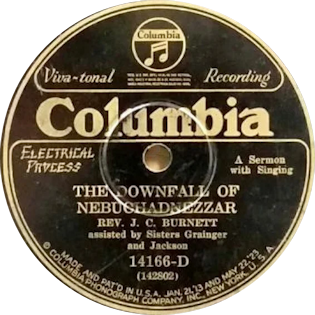 
|
____________________________________________________________________________________________________________________________
 A B C D E F G H I J K L M N O P Q R S T U V W X Y Z
A B C D E F G H I J K L M N O P Q R S T U V W X Y Z
To help with further browsing click on the large ‘Initial’ to return to the Early Gospel Singers Introduction, or click another initial to take you to details of more early gospel singers.
____________________________________________________________________________________________________________________________
Please Note:
As this is a continuously developing website, several entries only give the names with no biographical details. Please be patient as these entries are included for completeness, indicating the details are ‘coming soon’ and will be added when time allows.
If there are any early (pre war) gospel singers missing from the lists that you think should be included, please email the details to alan.white@earlygospel.com. Thank you in advance for your assistance.




